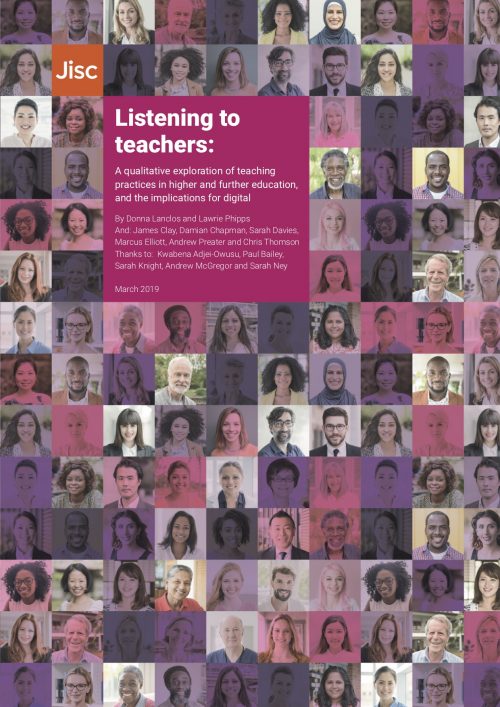Weeknote #10 – 10th May 2019
Author: James Clay
Go to Source

With the bank holiday, a shorter week starting on the Tuesday. It was a pity the weather wasn’t better for the bank holiday weekend, so was slightly annoyed as I arrived for work in bright sunshine.
Tuesday was very much about touching base with people in person. Yes you can do this online or remotely, but there is something about that happenstance that occurs within an office environment.
There was some discussion about the ALT Conference this year, which is taking place in Edinburgh. Alas I won’t be going this year as I will need to be close to home as my youngest starts secondary school, and as most people know, transition is a challenging time for all. I have been going to ALT since 2003 when I presented at the conference in Sheffield. Since then I have been to virtually every conference , except 2004 in Exeter and 2013 in Nottingham. I missed Exeter in the main as I wasn’t presenting and I hadn’t really enjoyed the 2003 experience. I missed 2013 as I had just started a new job at the beginning of September in 2013, so couldn’t get funding. Since joining Jisc in 2015, I did go to Manchester that same year, Warwick in 2016, I enjoyed Liverpool in 2017 and returned to Manchester in 2018. This blog post describes my #altc journey.
I had an interesting discussion over lunch on wellbeing and mental health, and the potential of data and analytics in supporting (staff who support) students in this space.
As I said in a previous weeknote:
I think it’s important that when we say something like…
Working on how data and analytics and other technology related approaches can support mental health and well-being for staff, students and researchers.
That what we’re actually saying is something more like…
Working on how data and analytics and other technology related approaches can provide insight, intelligence and inform those staff and services that work in this space and support the mental health and well-being of staff, students and researchers.
Later in the week, HEPI published a policy note on Measuring well-being in higher education. For me one of the key points was this.
The conflation of mental health and well-being is not helpful for tackling either low levels of well-being or supporting those suffering mental ill-health.
The two issues are related, but they are not the same thing. Interventions can support both issues, but different approaches often need to be taken in order to increase well-being compared to supporting those with mental health issues.
Next week I am off to the University of Hertfordshire to participate in a series of workshops looking at the value of Jisc to our members. I was asked to facilitate sessions relating to that old chestnut of mine, the Intelligent Campus, but will also be supporting sessions on Learning and Teaching and Next Generation Learning Environments. Whilst preparing for this session on Wednesday I was reminded of the reports that have been published in this space by Lawrie Phipps.
The first was the report on the Next generation [digital] learning environments: present and future challenge.
The report was a response to the challenge of the following questions:
- What would an environment do for staff and students?
- What kind of learning experiences would an environment need to support?
- What learning and teaching practices aren’t currently supported in environments?
The report makes for interesting reading
The changing nature of student and staff behaviours was something highlighted by many commentators; technology-led pedagogies, and emphasis on system features was another; and of course many people in the sector were commenting on the rise of analytics and the role that data may play in future systems.
As Technology Enhanced Learning continues to develop, it is clear that some form of digital learning environment will remain core to institutional practices; the levels of integration, features and porosity will continue to change, driven, and potentially driving the behavioural shifts we see in staff and students.
The second report which was researched as a result of the earlier work, with the aim to gain a detailed understanding of current teaching practices in universities and colleges.
Listening to teachers: a qualitative exploration of teaching practices in HE and FE and the implications for digital. The concluding remarks make for interesting reading and provide food for thought for all those who are supporting and embedding the use of technology for learning and teaching.
Practitioners are struggling with the disconnect between what they need to do in the spaces their institution provides and what is possible. Staff have to work harder to deliver the kind of teaching they want to in spaces that are not always appropriately configured. Some of this difficulty is a result of limits on space as a resource, however, there is also an element of staff not always knowing what is possible in the spaces available.
Interviewees identified a lack of opportunity to reflect on and analyse their teaching practice. While there are forums and staff development opportunities, limited time is officially allocated to formatively evaluating how a course was delivered and received, beyond the metrics used for more formal summative evaluation.
The organisational distance between instructional designers, education technologists and the people teaching in HE and FE is clearly present in (the) data.
Institutionally provided systems are not single-stop places for practitioners, who use open web and commercially provided platforms as teaching and learning places. This is not new6, but it continues to have implications for the ways that institutions support and recognise teaching practices that leverage digital places and platforms.
I would recommend you read the whole report.
Also too some time looking at various university documents in preparation for a visit to the University of Hertfordshire next week. They certainly have some interesting ambitions for their student experience.

I smiled at the Wonkhe article on university car parking rankings.
Our calculations are based on the supply of parking (the number of spaces on campus) divided by the demand for parking (based on the percentages of students and staff driving or carpooling to campus). Such a clear methodology means we can ignore the qualitative opinions of students and staff, which are messy and difficult to put on a league table.
The environmental considerations appeared to be missed, but then you realise it’s just a parody. I once left a job, because of the car parking (well it was one of the reasons). We were moving campuses from a suburban campus with free parking, to a city centre campus where there was limited on-site parking and all day parking was (as it was right in the heart of the city) expensive. My hours were changing as well, so I would be teaching until 9:30pm, at which point I would be expected to use public transport (two buses) to get home. At this point I started looking for another job. Ironically I got a job at a city centre museum that had no parking either…
Even today my job with Jisc, our head office in Bristol has no staff parking, so I do the train instead, which actually is frequent, reliable (a lot of the time) and about the same price of parking and the cost of petrol. The main difference is that I don’t need to be in the office everyday, so commuting is much less of headache.
Spent some time reviewing my personal objectives for the rest of the year (which is the end of July 2019) as well as reflecting on potential objectives for the following year. In theory we use a platform called Fuse for our objective setting, I though put most of the detail into Confluence, and then using reporting on Jira tasks to pull out and provide the evidence for those objectives. I can also pull out a report of tasks I have done that are not related to objectives. This evidence is useful when pulling together end of year reviews (and mid year reviews too).

![Next generation [digital] learning environments: present and future challenge.](https://elearningstuff.net/wp-content/uploads/2019/05/JR0090B_NDGLE_REPORT_EXECUTIVE_SUMMARY_SINGLE_PAGE_MAY18-500x707.jpg)
